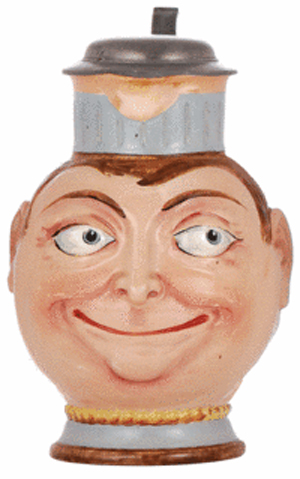
Beer steins have long been popular. Today’s stein is a beer container with a hinged lid and a handle. The lid was the result of health regulations.
The bubonic plague of the 1300s, which killed more than 25 million Europeans, and an influx of flies in Europe in the 1400s led to laws that required foods to be kept in covered containers. A hinged lid was added to a mug to make a stein.
Most beer steins collected today date from after 1800 and are made of pottery. One famous German company that used the mark “Gerz” opened in 1857 and remained in business until the 1990s. (A new company with the same name was recently established in Germany and is using the old Gerz triangle mark.)
Gerz made steins using glass or pottery. Its figural 3-D character steins that look like animal or human heads, usually comic, are especially popular.
A Smiling Face pottery stein marked “Gerz” sold for $529 at an auction in June.
Q: I have a Hoosier-style Sellers one-piece cabinet that my mother purchased secondhand in the 1950s. I’ve been unable to figure out how old the cabinet is. The cabinet was a mint-green color originally, and still has the original flour sifter. Can you help?
A: Hoosier cabinets were first made by Hoosier Manufacturing Co. of New Castle, Ind., about 1900. The freestanding kitchen cabinets had a work surface and shelves and drawers fitted with a flour sifter, coffee and tea canisters, cracker jars and other kitchen items. Soon all similar cabinets by other makers were called “Hoosiers.” The G.I. Sellers Co. was the second-largest manufacturer of Hoosier-style cabinets. The company was founded by George Sellers in Kokomo, Ind., in 1888 and moved to Elwood, Ind., in 1905. It closed in 1950. Hoosier-style cabinets were made until the 1930s, when built-in kitchen cabinets became popular.
Q: I have a set of dishes that are green and white and have a scene of the interior of what looks like a log cabin. The dishes are marked “Colonial Homestead by Royal.” The scene on the plates includes a table, chairs, grandfather clock, large fireplace with hanging cookpots and an old-fashioned gun over the fireplace. This set was left to me by my great-uncle. It includes service for six people and includes plates, small bowls, cups and saucers, a platter and a vegetable bowl. I’d like to know how old these are and what they might be worth.
A: The Royal China Co. was in business in Sebring, Ohio, from 1934 to 1986. The company made dinnerware, cookware and advertising premiums. The Colonial Homestead pattern, which includes scenes from a Colonial home, was designed by Gordon Parker. It was introduced about 1951 and was sold by Sears, Roebuck & Co. through the 1960s. The dishes sell for very low prices today.
Q: I have an old ticket that was my great-grandfather’s. It’s for a “Mexican Bull Fight” held in the Cripple Creek district of Colorado in August 1895. I understand this was the only bullfight held in the United States. Any idea what the ticket might be worth?
A: The Mexican bullfight held in Gillett, Colo., on Aug. 24-25, 1895, was billed by its promoter as “the first bullfight held in the United States.” Two professional bullfighters from Mexico were hired, but the bulls, whether imported or homegrown, were unenthusiastic participants — so, according to most accounts, the event was a fiasco. A planned third day was canceled, area humane societies protested, and those who attended wanted their money back. The Denver Public Library has a ticket like yours in its collection, and other historical societies around Cripple Creek (south of Denver) probably would like to own one. You might consider donating yours. If you decide to sell, contact an “Old West” auction, where you would probably get the most money (it’s impossible to predict how much). Gillett, by the way, was a Gold Rush town that’s now a ghost town. Bullfighting was banned in the United States in 1957 — although so-called bloodless bullfights are held in some U.S. communities.
Q: We found a Civil War discharge paper for Jasper Noon in my mother-in-law’s estate and are wondering whether it has any value.
A: Interest in Civil War items is expected to increase this year during the 150th anniversary of the start of the war. Civil War discharge papers sell for $60 to $80.
Current prices
Prices are recorded from antiques shows, flea markets, sales and auctions throughout the nation.
- MasterWare cake carrier, chrome, square, holds a 12-inch cake or pie, Buffalo, 1960s, $40.
- Waterford crystal pitcher, Lismore pattern, signed, 61/2 inches, $110.
- Stork Club bud vase, stork wearing top hat, painted wood with glass tube, 7 1/2 inches by 4 inches, $385.
- Dave Clark Five figures, rooted black hair, jointed at neck, embossed “Dave,” “Rick,” “Dennis,” “Mike” and “Larry” on shirts, Remco Toys, 1964, set of five, 4 3/4 inches, $395.
- Vogue Jennie Southern Belle Make-Up Doll, blond hair in curls with bangs, pink flower-print bonnet, dress and petticoat, carrying purse with cosmetics, 1940s, 19 inches, $550.
- Cast-iron Cat and Mouse mechanical bank, clock with cat face, press lever and mouse sitting on top spins to reveal cat with mouse and ball, J.&E. Stevens, 9 inches, $645.
- Ayer’s Pills poster, stone lithograph, girl with white bonnet holding a box, “Ayer’s Pills Are Sugar Coated, Will You Have One?” J.C. Ayer & Co., circa 1905, 283/4 inches by 41 inches, $1,150.
Terry Kovel, an authority on collectibles, writes for King Features Syndicate. Write to her in care Auction Central News, King Features Syndicate, 300 W. 57th St., New York, NY 10019. The volume of mail makes personal answers impossible. She can’t guarantee the return of any photograph but will try if a self-addressed, stamped envelope is included. Visit her at www. kovels.com.


